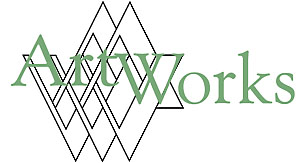
 |
Summer 2003 |
|
An interview with Denise Giardina ADA: Becoming Accessible From the Director A convergence of printmakers and potters Monoprints of Barbara Marsh Wilson Interview with Mark Wolfe |
Fiber artists share old traditions, new ideasStory and photographs by Maryann Franklin How many of you know what tatting is? It’s a lace-making technique that uses thread and a plastic or metal shuttle. “The hardest job I ever had,” Eloise Sibold said, “was trying to teach someone who is left-handed to tat. But I finally helped her get the hang of it.” Sibold is a member of a most unusual and enduring group of artisans, the Fiber Network. The Greenbrier County organization is not about optics or technology, a mistake people sometimes make when they hear the name, but something much more basic. Something, in fact, that serves as a base for other crafts: Fiber for thread and cloth.
Some guilds or artisan groups join together in search of discipline or inspiration, some to market their wares. The fiber network meets simply to find joy and inspiration in their arts and to share their experience and expertise. They range in age from eight to over 80, although most members fit into the “mature” category. They come from four surrounding counties (Greenbrier, Monroe, Summers and Pocahontas), with an occasional visitor from farther afield (Blacksburg, for example). The Fiber Network is both loosely knit and loosely structured. Though there are about 45 members, most meetings are considerably smaller. Numbers vary from meeting to meeting. When I asked a question, I often got a chorus of individual answers, as they looked up from their labors. “There are no rules.” “We let everybody do what they want.” “Sometimes in the winter, we come just to get out, to escape, to share some camaraderie.”
“ The best part of being in this group is that we inspire each other,” said one member. “Sometimes, you end up involved in something different just by watching others.” At meetings, they share information both formally and informally. They also take field trips to processing mills to learn about fiber and color blending, etc. They hold a sale of their wares the first Saturday of each December. “We call it the Cabin Sale. It was actually started by a member, a potter, in a log cabin that belongs to her.” Now it’s a holiday tradition. In addition to their individual efforts and regular get-togethers, they schedule an annual retreat weekend at Hawks Nest State Park each spring, committing time to be together and to complete their projects. If someone gets stuck on a difficult knitting or weaving project, she turns to the others for answers. “Someone’s always there to give you instructions and tell you what to do to solve a problem,” one member commented. “You don’t have to reinvent the wheel,” remarked another. “I’ve been part of groups where people won’t tell anything,” commented Sibold. “We don’t keep secrets here. We share our knowledge.” “It’s silly not to share what you know.” “We share information. We share patterns.” “ We share magazines.” “We share everything except our husbands!” A bit of information they shared with me may surprise you, as it did me. The ladies keep their wool and yarn in the freezer. It’s the best way to eliminate moths! Every year the group sets up a spinning and weaving demonstration booth at the West Virginia State Fair, where they teach children the basics of weaving on cardboard looms. This, in fact, is how they earn the money to pay for the large classroom they rent from Carnegie Hall. “We contribute to the community as well as to each other, “ explained Laurie Caudill, the group’s acting president. “We’re teaching and preserving lost arts.” The members talk eagerly about their joy in working with children. They often visit local elementary schools to give talks and demonstrations, allowing students to learn in different ways: teaching, seeing, touching, experiencing. Many children don’t even know where wool comes from, or any part of the processes that turn it into cloth. Many have never even seen a spinning wheel. Eloise Sibold has been visiting elementary schools for many years. She began visiting a Kindergarten class in Frankford when her grandson, now a sophomore in college, was in the Kindergarten class. “These things are worth preserving, said member Sarah Allen. “Spinning, to me, is like a Zen meditation. I try to spin for at least 30 minutes every morning.” |